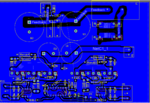barry
Advanced Member level 7

- Joined
- Mar 31, 2005
- Messages
- 6,565
- Helped
- 1,206
- Reputation
- 2,424
- Reaction score
- 1,436
- Trophy points
- 1,393
- Location
- California, USA
- Activity points
- 35,700
I think also need to look at Vgs and Vds from the the OTHER FETs as well. It looks like maybe you've got some timing issue between the two channels. (One channel turning on before the other one has turned off).
Also, it's not clear WHAT that bottom plot is showing; please explain. But if that's showing spikes on your power supply then you're either picking up junk on your scope ground lead, or you haven't properly decoupled the power supply.
What's your load?
And those 100pF caps seem awfully small for their intended purpose; you've got a lot of power to deal with here and 100pF can't store a whole lot of energy.
Also, it's not clear WHAT that bottom plot is showing; please explain. But if that's showing spikes on your power supply then you're either picking up junk on your scope ground lead, or you haven't properly decoupled the power supply.
What's your load?
And those 100pF caps seem awfully small for their intended purpose; you've got a lot of power to deal with here and 100pF can't store a whole lot of energy.











